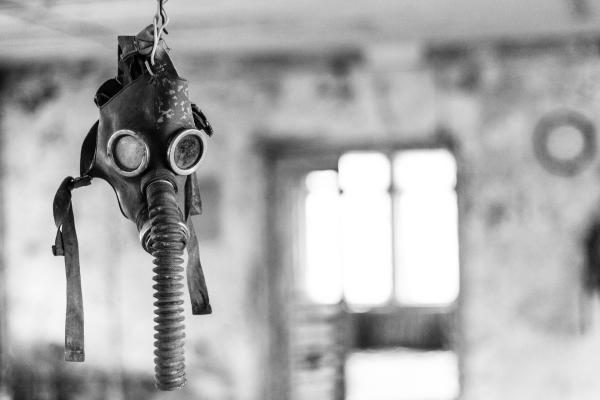Here’s what I’ve been able to find out to date.
How are they measuring radiation around Chernobyl?
Ever since the 1986 nuclear reactor accident, there has been a radiation monitoring network throughout Ukraine, keeping track of radiation exposure from Chernobyl’s aftermath. Over the years, detectors have been added and upgraded, including bringing the readings to the internet (which didn’t even exist in 1986!). Here is one such site, although I have to admit that I can’t vouch for the readings’ accuracy or timeliness.
How high did rad levels increase, and are they dangerous?
The highest radiation levels noted are on the reactor site and are a few to several milliroentgens/hr (mR/hr) – these are clearly higher than natural background radiation; on the other hand, a person spending all of their time in an area with a dose rate of, say, 1 mR/hr would receive only about 24 mR each day, far less than the 100,000 mrem needed to cause radiation sickness. So, while this isn’t a place where we’d want to live, radiation levels are too low to pose a health risk over days or even weeks. The greatest danger to anybody in the area is the fighting and the war.
Why did radiation levels increase?
The most likely reason, according to the International Atomic Energy Agency (IAEA), is that the fighting and heavy vehicular traffic have brought up some radioactive contamination from deeper layers of soil – most likely radioactive cesium (Cs-137), strontium (Sr-90), and other longer-lived fission products. As the wheels, tank tracks, and explosions dig into deeper layers of soil, they bring up the contaminated soil, increasing radiation levels. Most importantly, the IAEA feels that the reactor itself has not been further damaged.
Are any of the reactors at risk from the fighting?
It’s hard to give any definitive answer without knowing what weapons might be used. It seems safe to assume that bullets and grenades are unlikely to cause any problems; the new containment structure over the ruined reactor is concrete and can certainly withstand these smaller weapons. But when it comes to artillery, mortars, and bombs…there’s just no way to know how much punishment the containment would be able to take. Luckily, everyone fighting in the area knows about the presence of the reactors; we can only hope that they are being careful to avoid targeting them.
How far will the contamination spread?
Likely not very far, primarily because tanks, trucks, and even artillery explosions can’t throw dust high enough in the air to travel more than a few miles. The reason that contamination from the nuclear reactor accident traveled so far is that it rose to a height of several miles – high enough to reach upper-level winds that carried it around the world. But even a high-explosive artillery shell doesn’t send dust that high.
Are there any operating reactors left at Chernobyl?
Nope! All of the reactors have been shut down for years and are in various stages of decommissioning.
How do you know all this stuff? Are you over there?
No – I’m in the US, but there’s a lot of information available online (I’ve included links to some of these sites), including from organizations with a deep understanding of radiation, radiation safety, nuclear reactors, and reactor accidents. Other links noted below appear to have accurate information about these events.
Are any of the people in the area at risk?
From the war – yes. From the radiation – no. As noted above, the radiation levels are elevated but not nearly high enough to cause radiation sickness or other problems. Earlier, I mentioned that contaminated dust is likely the cause of the increased radiation levels; it’s natural to wonder if inhaling this dust will put people at risk. The short answer is that it’s not likely – first, because people tend to put on masks if the dust is thick enough to be a bother, and second because the radioactive cesium in the dust tends to pass through the body very quickly. So there shouldn’t be much radioactivity entering the body to begin with, and what does get in should be excreted within a few days.
One last comment…this is an evolving situation, and we can expect conditions to change over time. If anything significant happens that might lead to the release of large amounts of radioactivity or that might damage the reactor containment, I’ll update this piece. As of now, the consensus seems to be that fighting at and around the Chernobyl site is not creating a radiological risk for the people on or near the site, nor for those living nearby…and certainly not for anybody outside of the immediate area.
Useful Links
LiveScience https://www.livescience.com/russia-invades-chernobyl
New York Times https://www.nytimes.com/2022/02/25/science/chernobyl-ukraine.html?searchResultPosition=1
Washington Post https://www.washingtonpost.com/world/2022/02/25/ukraine-russia-chernobyl-hostages-radiation/




